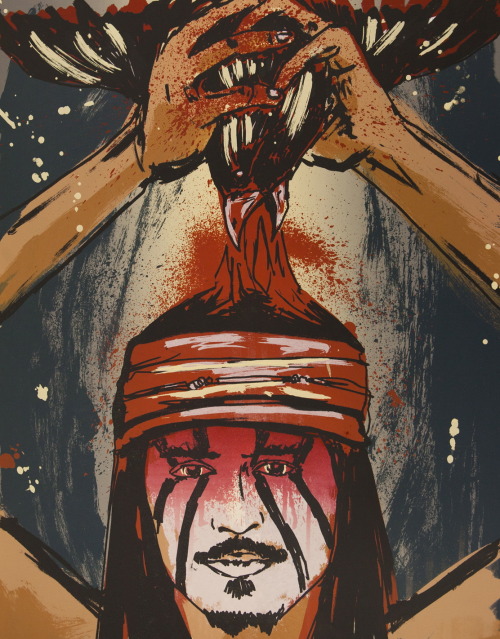What’s the first thing that comes to mind when you think of Native American art? If you’re anything like the majority of non-Native Americans, a vague jumble of pottery, baskets, and blankets probably sums up all you know about Native art. But what about prints, photographs, paintings, and all the other forms contemporary art can take? Native artists have been creating incredible, inventive contemporary art for decades, but most Americans have no clue.

Here’s a piece of contemporary art you’ve probably never seen before: “Animals out of Darkness,” a 1961 print made by Inuit artist Kenojuak Ashevak and displayed in “Decolonizing the Exhibition,” a show of modern Inuit art hosted by the Frances Lehman Loeb Gallery at Vassar College.
The reasons for this knowledge gap, said the artists, collectors, and curators on the panel Decolonizing the Exhibition: Four Perspectives on Indigenous Visual Culture in the Museum Space, are numerous. First off, very few museums exhibit contemporary Native art. Some own contemporary pieces but never let them out of storage, while others display only decades-old examples of “traditional crafts” that are often viewed from an ethnographic perspective—that is, not as works of art, but rather artifacts that provide information about the life ways of Native peoples.
For example, a look through the Metropolitan Museum of Art’s website revealed a single gallery containing the “art of Native North America,” part of a larger collection entitled “Arts of Africa, Oceania, and the Americas.” The most recent pieces in that gallery are “1970s-era tobacco bags.” By contrast, the American Wing has 73 galleries, while the Modern and Contemporary Art collection hosts over 12,000 works by a wide range of international artists dating from 1900 to the present. Although it would have been impossible to look through the combined 29,000 pieces in these two collections, the fact that the gallery of Native art is separate from both the American and the modern collections suggests that few to none of the works in the two latter collections are by Native artists.

The gallery of Native North American “artifacts” at the Metropolitan Museum of Art.
In addition to this museum conundrum, the panelists pointed out that Native Art is rarely studied or discussed in academia. Sarah Sense, a Native artist with bachelor’s and master’s degrees in art, said that she had never taken a course in Native art and had rarely seen any examples of it during her time in art school. Similarly, Pilar Jefferson, an art history major at Vassar, said that she had never discussed Native art in the classroom.
This erasure of contemporary Native artists has a range of negative consequences. By only exhibiting works that are generally over a century old, museums reinforce the Eurocentric narrative that Native Americans all died off or simply vanished after the arrival of European settlers. And by displaying Native art as ethnographic artifacts or traditional handicrafts, museums negate Native artists’ creativity and ability to respond to the modern world.

“Red Raven, Red Raven,” a screen print made by Tom Greyeyes, a contemporary Navajo artist, in response to Johnny Depp’s portrayal of Tonto in the recent film adaptation of “The Lone Ranger.” This is one of many examples of Native artists critiquing the portrayal of Native Americans in popular media.
From both the panel and the exhibition of contemporary Inuit art in the Loeb Gallery, it quickly became clear that contemporary Native art is not only real but thriving, addressing everything from the incorporation of modern technology into traditional life ways to the portrayal of Native Americans in the media. Contemporary Native American pieces are not crafts or artifacts; they’re works of art.
To see more contemporary Native American art, check out the following links:
The Museum of Contemporary Native Arts
Sources:
Image 1: http://fllac.vassar.edu/exhibitions/2013-2014/decolonizing-the-exhibition.html
Image 2: http://www.metmuseum.org/collections/galleries/africa-oceania-and-the-americas/356
Image 3: http://greyeyesart.tumblr.com/post/40572705158/painting-yourself-red-still-wont-make-you-a-red#notes




 This photo illustrates this pretty well. See how the ground on the far side of the wall is lumpier, rockier, and has bigger trees, while the ground closest to the camera is flatter and has fewer rocks and smaller trees? That flatter ground was probably a field.
This photo illustrates this pretty well. See how the ground on the far side of the wall is lumpier, rockier, and has bigger trees, while the ground closest to the camera is flatter and has fewer rocks and smaller trees? That flatter ground was probably a field.
 A tree in a pasture vs. trees in a forest. Note the differences in shape and number of low-lying branches.
A tree in a pasture vs. trees in a forest. Note the differences in shape and number of low-lying branches.